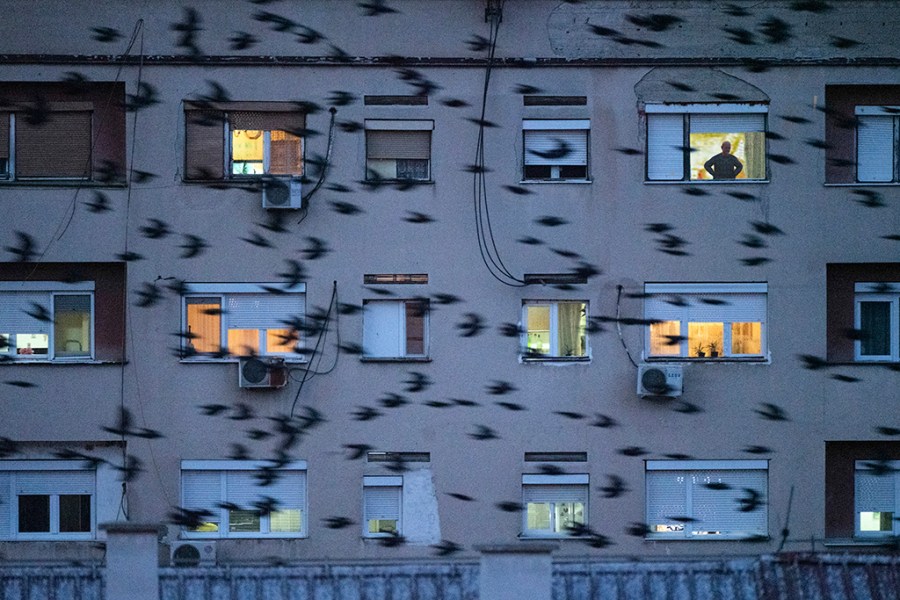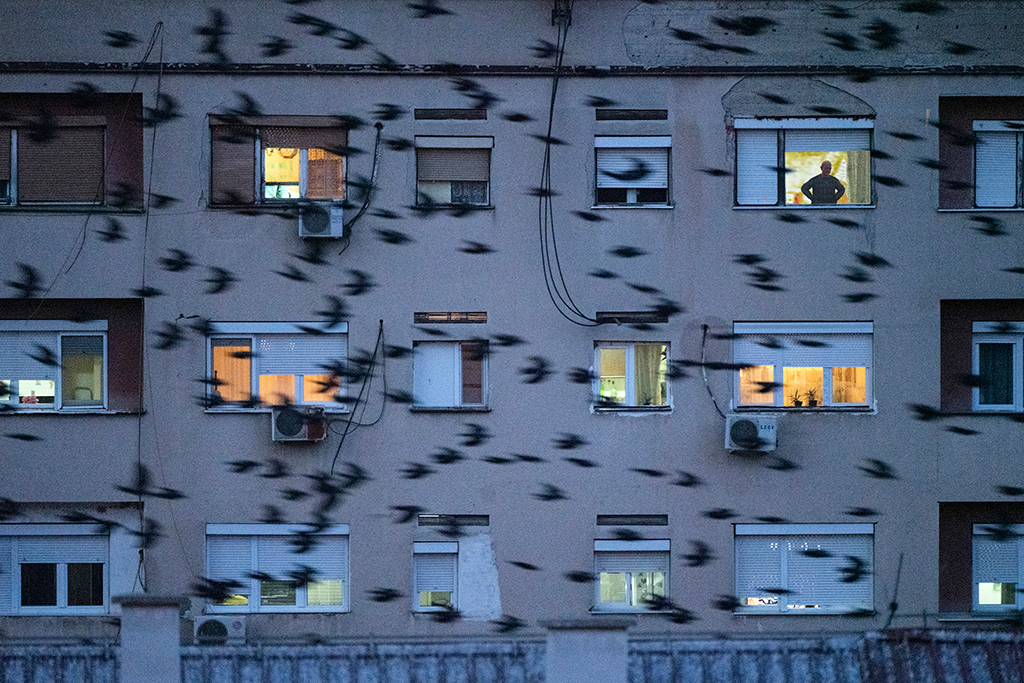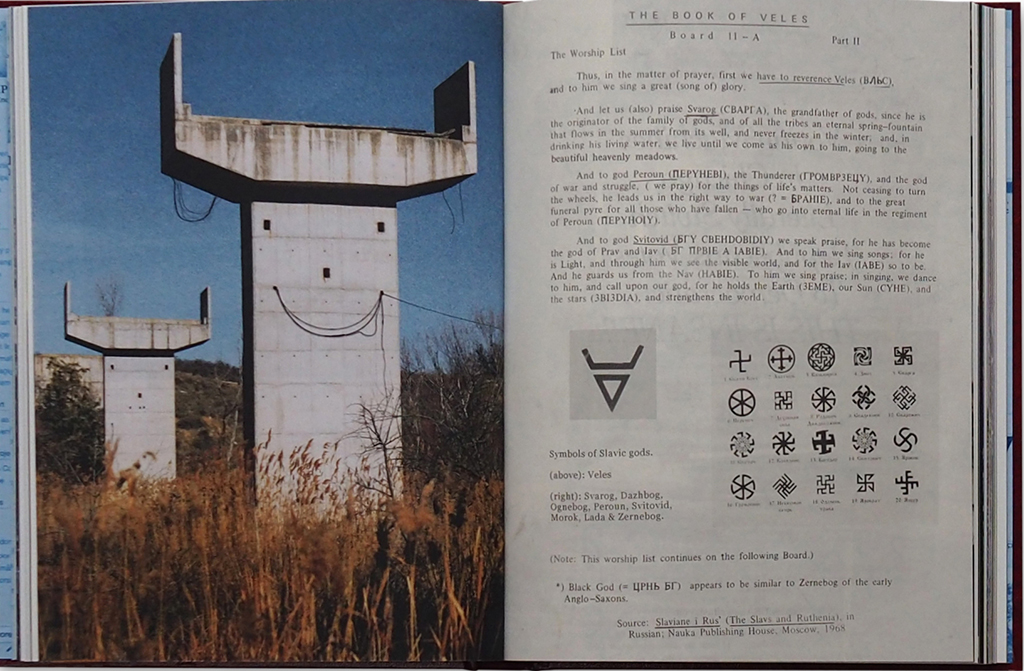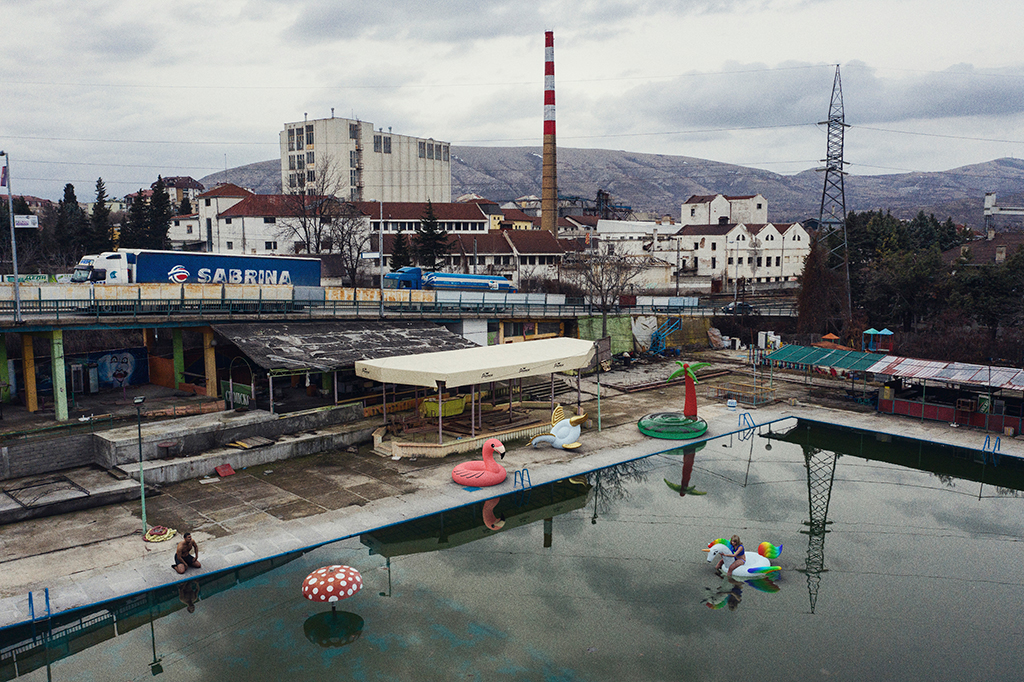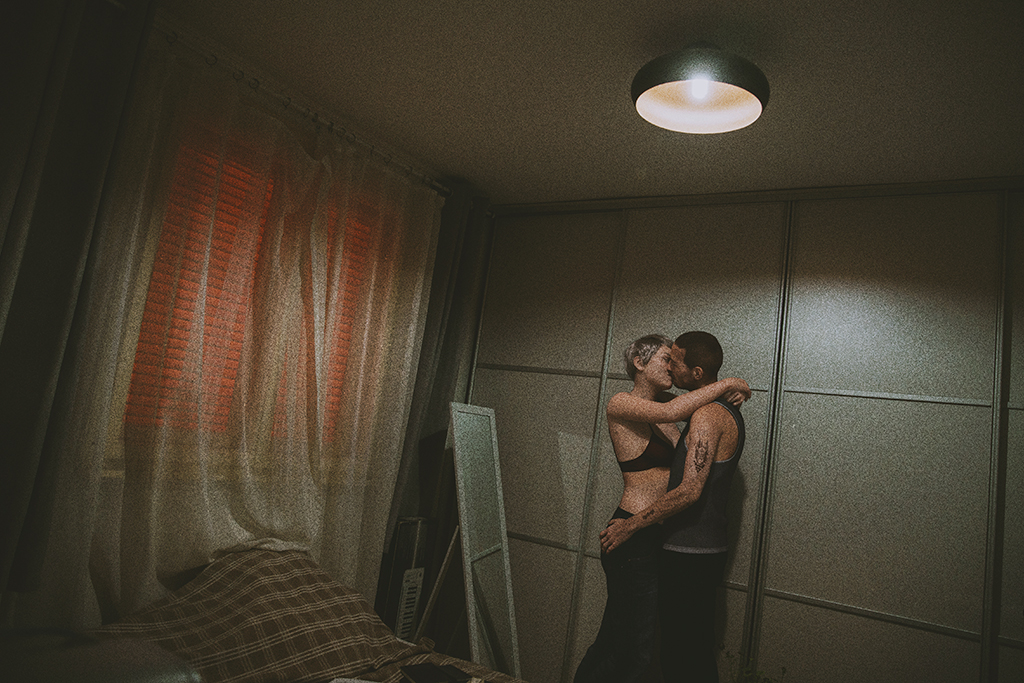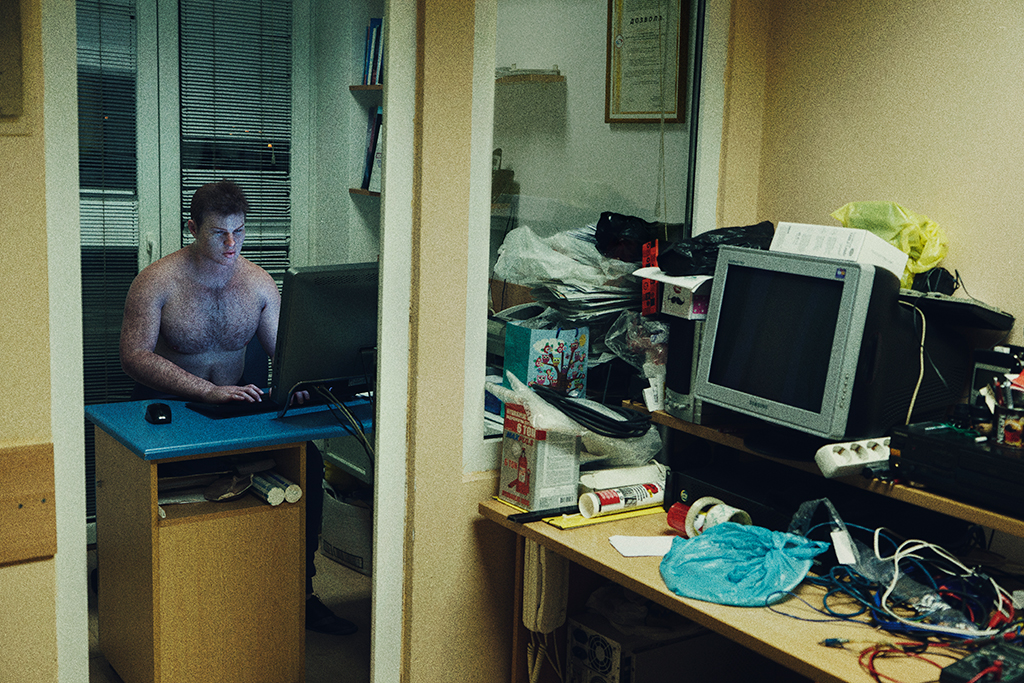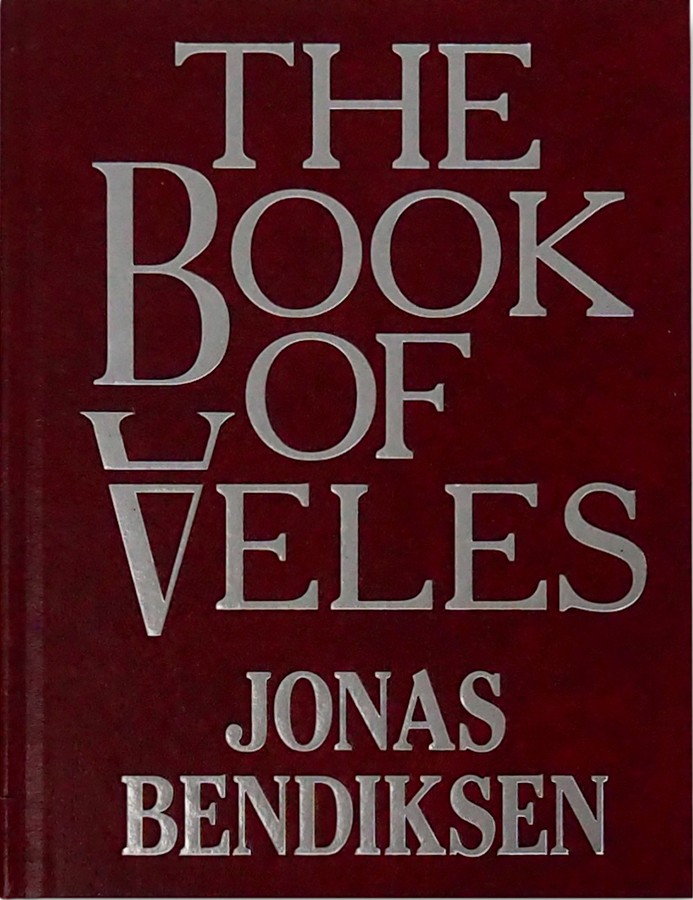The story behind The Book of Veles by Jonas Bendiksen is as extraordinary as the fake news business that motivated it. Peter Dench, a real-life human, finds out more
The 5,000-word introductory text to The Book of Veles is a detailed and thrilling read. Renowned Magnum Photos photojournalist Jonas Bendiksen (b.1977) recounts his travels to the North Macedonia city of Veles which came to prominence in 2016 as a world capital of fake news. The Norwegian national roams around the squalid streets and derelict buildings to find and photograph people involved in the fake news business.
He meets the tall thin mayor, Diokno, with a large moustache and bald head. He meets Goran, an internet troll, dressed in jeans, T-shirt and hoodie who has dark hair parted in the middle. Eighteen-year-old Bojan is dressed in a green and black striped shirt and brown shoes. Andras has a grey ponytail, shock of grey hair, small smile and a tattoo on his left shoulder that reads ‘Macedonia.’
There’s a killing, an attack and inspired interlude where Bendiksen interrupts his fake news investigation to find and photograph a sleuth of bears running amok. He parks his car and, with little regard for his own safety, walks into the forest of big trees with big branches.
The images in the book are classic Bendiksen, carefully crafted photographs in the style to which we have become accustomed from his archive of award-winning photo-essays. A young girl sits on an inflatable unicorn in a dirty-looking swimming pool as trucks thunder along a nearby road. A silhouetted man looks out from a dilapidated apartment block at a flock of birds in flight.
A dark-haired woman stoops to peer into a car parked in a menacing-looking lamplit alleyway, a man lurks in the shadows. The images portray what we’ve come to expect from a seedy, mafia-run, drug-dealing, crumbling former Eastern Bloc country. And there are the photographs of bears: a bear crossing the road caught in car headlights; a bear strolling among the shadows; a bear drinking from a river next to sign for the Royal Norway Embassy complete with painted Norwegian flag.
It’s accomplished and convincing. It’s also completely fake. The people in Bendiksen’s photographs are fake, some objects are fake and the bears are fake (bizarrely, the Royal Norway Embassy sign is real). The introductory text is fake. He didn’t write a word of it, instead using GPT-2, a free trainable system for creating text. Bendiksen went online, copied and pasted articles reported by English-language media about the fake news industry in Veles onto one long text document and fed it into the system – out came a passable carbon copy of a human handwritten article.
The only part of the book that has not been tampered with are the direct quotes from fake news websites, which are essentially fake. Bendiksen deliberately set out and succeeded in hoodwinking the global photographic community with his audacious The Book of Veles. This is how and why he did. Bendiksen travelled to Veles in 2019 and 2020 to photograph the streets, alleys, landscape, empty spaces, park benches, offices and anything that caught his interest.
He photographed these with his regular camera and also captured the lighting of each scene using a special 360-degree camera combined with special effects methods. With his visual haul complete, as the world began to lockdown from Covid-19, he retreated to the basement of his home on a peninsula near the Norwegian capital of Oslo, settled among his books and family photographs, closed the curtains and went about his skulduggery.
Learning to use video game production software from online tutorials, he transformed an edit of his images from Veles into 3D renderings then went shopping online for digital avatars to populate them. The €20-30 price wasn’t a problem but they didn’t look like North Macedonia citizens. ‘They’re all these Barbie and Ken bimbo types, they look really ridiculous, it’s not so easy to find people who look like you.
You want people who look kind of normal. The first thing I did with all of them was fatten them up a bit, give them some bad skin, get some dimples and some scars,’ explains Bendiksen during our Zoom call (at least I think it’s Bendiksen – scrutinising the bags under his eyes they look real, testament perhaps to his three children and an imminent fourth).
He then went shopping, buying clothes and lingerie for his avatars. ‘I have to admit I’ve done exactly that. If someone had asked me three years ago if I would be spending most of my time dressing up digital Playmobil characters and playing with computer game bears for a living, I would say they were pretty crazy.’ The avatars were placed into his scenes, then posed and lit to make everything look as realistic as possible before transforming back into 2D. Professor Bendikenstein’s creation was ready.
Why
During the election campaign of Donald Trump and throughout his presidency, Bendiksen became increasingly frustrated reading reports of Russian hacking and fake news. He feared a tsunami of advanced all-digital technology and began to question how long it would be until documentary photojournalism could have no
basis in reality other than the photographer’s fantasy and a powerful computer graphics card.
Would editors be able to tell the difference and how hard is it to do? Bendiksen was so frightened by what the answers might be, he decided to try it himself – his own visual Turing test. If one averagely nerdy photographer could watch a bunch of YouTube videos and subvert the documentary tradition of photography, then it would be a warning to us all.
By April 2021, The Book of Veles was ready for publication by GOST books; director and cofounder Stuart Smith was in on the hoax from the beginning. Snippets of the book were fed to social media and Bendiksen waited for people to question the work. No one did, there were likes, thumbs up and heart emojis. His fellow Magnum photographers were fooled. Some who bought the book applauded the important story he was telling.
Leica’s LFI magazine dedicated a page to the book describing it as ‘intelligent and entertaining’. Bendiksen was careful not to let the work be published in magazines outside of the photographic community so when the truth came out, those who were duped had a better chance of finding out. The months rolled on.
For Bendiksen’s caper to work and create a debate in photography about the escalation of deceptive technology, he had to test it against some of the world’s most visually sophisticated people. He chose the Oscars of his industry, the Visa Pour l’image Festival of Photojournalism. Bendiksen submitted the image series and full-resolution PDF of the book.
The festival came back with the offer of an evening screening; no one at any stage raised questions about the authenticity of his reportage. On 1 September, the photographic elite settled under the Perpignan night sky at Campo Santo and looked up at the 100-metre screen as a short video of Bendiksen’s images of bears and bare-chested men rolled past.
Bendiksen had arrived early, wore a mask and watched awkwardly from high up in the seats. ‘I didn’t say hello to a single person while I was there. I was so uncomfortable. I stayed in my hotel, ate dinner on some backstreet far away from the festival crowd. I didn’t want to meet anyone and face interaction,’ he says.
Truth
With the collateral damage done, Bendiksen rapidly extracted himself from France. Back home the next day, he set about revealing the truth before the festival ended a few days later. He was prepared, having spent weeks creating and curating a pre-aged fake Facebook profile for Chloe Miskin, born on 21 February 1994, a self-employed photographer from Veles, living in Manchester, UK (who curiously studied at St Cyril & Methodius University of Dentistry, Skopje, Macedonia).
Bendiksen logged into Miskin’s account and accused himself of fraud and paying the people in his pictures: ‘Every time Jonas puts out a picture on his Instagram, people are saying what a great project this is, but it is not, his project is the real fake news!! Really, somebody should investigate this.’ After a muted response, he reposted the allegations in a private photography Facebook group.
His approach was largely defended. With his atonement in tatters, he frantically enrolled Miskin at the home of trolls, Twitter, where she continued her accusations. Benjamin Chesterton, aka Duckrabbit, the scourge of deceitful photojournalists, spotted that one of the fake account’s profile pictures was an outtake of a woman that appears in The Book of Veles wearing the same clothes. The unravelling had begun and like many criminals, Bendiksen was relieved to have finally been caught.
On 17 September 2021, the story behind The Book of Veles was posted on the Magnum Photos website, and the director of Visa Pour L’image, Jean-François Leroy, responded with a 500+ word statement – he was flabbergasted and stunned: ‘Jonas Bendiksen is a regular at Visa Pour l’image, and has had a number of exhibitions and stories screened.
Given the relationship based on friendship and trust we have with him, as with dozens of other photographers, could this explain how we were trapped? Would we have been more cautious if dealing with an unknown photographer? Maybe, maybe not. Quite obviously, we would have preferred not to be the target of his joke. But we weren’t the only ones.
Magnum also fell into the trap, the agency of Capa and Cartier-Bresson who attached so much importance to facts and truth. But such considerations are now irrelevant. The deed has been done. For some time now, the festival has wanted to include fake news and raise awareness on fake news as part of the program, but ideas and proposals by members of the team have remained incomplete. In the end, Jonas Bendiksen’s insolent daring has, for better or for worse, raised the issue to a level we would never have thought possible.’
Ancient book
In another delicious layer to his prank, while researching for the project Bendiksen discovered there was an ancient Book of Veles (from which he borrowed the title), a literary forgery purporting to be a text of ancient Slavic religion and history supposedly written on wooden planks. The planks are said to have been discovered in 1919 by White Russian army lieutenant Fedor Izenbek and decoded decades later by Yuri Mirolyubov, who disclosed it was an epic tale about early Slavic people and the god Veles, a god of magic and trickery who the Slavs initially believed would visit the mortal world in the form of a bear – you couldn’t make it up, well actually…!
Bendiksen fed the entire scripture into GPT-2 and went to bed. The next morning he had multiple versions to modify and interspersed the vaguely relevant historical passages throughout his own forgery.
In 2013 Bendiksen took my then eight-year-old daughter and I on a boat trip across a fjord fishing for pike. He advised where the jellyfish weren’t so we could swim safely. During lunch, we played the head, body and neck drawing game – while no one is peeking, the first person draws the head and neck and folds over the paper leaving a little bit of the neck showing, the next person draws the middle down to the waist and folds, the next person draws the legs, unfold the paper and hilarity ensues at the mismatched creation (early inspiration for his avatars?).
Bendiksen’s persona is one of care, confidence and trust. His photographic legacy is honest and thorough. If he frothed prophecies I’d listen. If he tried to sell me a bible, I’d probably buy it. Once you know that everything in The Book of Veles is fake it looks obvious but as a trusted source, the industry wasn’t sharpened to question Bendiksen’s output. But, it needs to as the consequences could be irretrievable as he admits.
‘I’ve lived with these pictures for some time now and when I go back into the material I’ve actually surprised myself and forgotten what was renderings and what was real. I’m starting to confuse myself.’
In hindsight, Bendiksen is the perfect person to do what hackers recruited by big tech companies regularly do – search for deficiencies in the system so they can be fixed. If computer-generated fake news pictures are accepted by editors and curators who pick the year’s best photojournalism, the system is weak. Documentary photography is unlikely to go away, authentic visual storytelling will always exist.
Manipulation in photography is nothing new but what is coming is something else and Bendiksen has cranked on the warning siren. He must have optimism for the world though to be bringing a fourth child into it? ‘Or a strong-willed wife. I feel blessed,’ he says, and The Book of Veles may in time turn out to be a blessing for us all.
A third printing of The Book of Veles is available to order here: www.gostbooks.com
Related Articles:
Is it a bird or is it a plane? Capturing Dod Miller’s Birdmen

